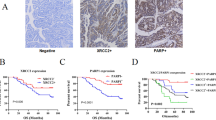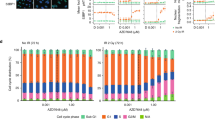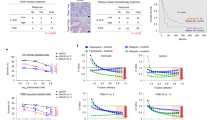Abstract
Monoagent DNA-alkylating chemotherapies like dacarbazine are among a paucity of medical treatments for advanced carcinoid tumors, but are limited by host toxicity and intrinsic chemoresistance through the base excision repair (BER) pathway via poly (ADP-ribose) polymerase (PARP). Hence, inhibitors of PARP may potentiate DNA-damaging agents by blocking BER and DNA restoration. We show that the PARP inhibitor ABT-888 (Veliparib) enhances the cytotoxic effects of dacarbazine in carcinoids. Two human carcinoid cell lines (BON and H727) treated with a combination of ABT-888 and dacarbazine resulted in synergistic growth inhibition signified by combination indices <1 on the Chou-Talalay scale. ABT-888 administered prior to varying dacarbazine doses promoted the suppression of neuroendocrine biomarkers of malignancy, ASCL1 and chromogranin A, as shown by western analysis. Ataxia telangiectasia mitogen factor phosphorylation and p21Waf1/Cip1 activation, indicative of DNA damage, were increased by ABT-888 when combined with dacarbazine treatment, suggesting BER pathway attenuation by ABT-888. PE Annexin V/7-AAD staining and sorting revealed a profound induction of apoptosis following combination treatment, which was further confirmed by increased PARP cleavage. These results demonstrate that ABT-888 synergizes dacarbazine treatment in carcinoids. Therefore, ABT-888 may help treat carcinoids unresponsive or refractory to mainstay therapies.
This is a preview of subscription content, access via your institution
Access options
Subscribe to this journal
Receive 12 print issues and online access
$259.00 per year
only $21.58 per issue
Buy this article
- Purchase on Springer Link
- Instant access to full article PDF
Prices may be subject to local taxes which are calculated during checkout



Similar content being viewed by others
References
Modlin I, Lye K, Kidd M . A 5-decade analysis of 13,715 carcinoid tumors. Cancer 2003; 97: 934–959.
Noel-Savina E, Descourt R . Focus on treatment of lung carcinoid tumor. Onco Targets Ther 2013; 6: 1533–1537.
Calender A . Genetics of neuroendocrine tumors. Rev Prat 2002; 52: 256–261.
Zuetenhorst JM, Taal BG . Metastatic carcinoid tumors: a clinical review. Oncologist 2005; 10: 123–131.
Rinke A, Muller HH, Schade-Brittinger C, Klose KJ, Barth P, Wied M et al. Placebo-controlled, double-blind, prospective, randomized study on the effect of octreotide LAR in the control of tumor growth in patients with metastatic neuroendocrine midgut tumors: a report from the PROMID Study Group. J Clin Oncol 2009; 27: 4656–4663.
Vilar E, Salazar R, Pérez-García J, Cortes J, Oberg K, Tabernero J . Chemotherapy and role of the proliferation marker Ki-67 in digestive neuroendocrine tumors. Endocr Relat Cancer 2007; 14: 221–232.
Kouvaraki MA, Ajani JA, Hoff P, Wolff R, Evans DB, Lozano R et al. Fluorouracil, doxorubicin, and streptozocin in the treatment of patients with locally advanced and metastatic pancreatic endocrine carcinomas. J Clin Oncol 2004; 22: 4762–4771.
Sun W, Lipsitz S, Catalano P, Mailliard JA, Haller DG, Group ECO. Phase II/III study of doxorubicin with fluorouracil compared with streptozocin with fluorouracil or dacarbazine in the treatment of advanced carcinoid tumors: Eastern Cooperative Oncology Group Study E1281. J Clin Oncol 2005; 23: 4897–4904.
Middleton MR, Grob JJ, Aaronson N, Fierlbeck G, Tilgen W, Seiter S et al. Randomized phase III study of temozolomide versus dacarbazine in the treatment of patients with advanced metastatic malignant melanoma. J Clin Oncol 2000; 18: 158–166.
Stupp R, Mason WP, van den Bent MJ, Weller M, Fisher B, Taphoorn MJ et al. Radiotherapy plus concomitant and adjuvant temozolomide for glioblastoma. N Engl J Med 2005; 352: 987–996.
Fine RL, Gulati AP, Krantz BA, Moss RA, Schreibman S, Tsushima DA et al. Capecitabine and temozolomide (CAPTEM) for metastatic, well-differentiated neuroendocrine cancers: The Pancreas Center at Columbia University experience. Cancer Chemother Pharmacol 2013; 71: 663–670.
Crona J, Fanola I, Lindholm DP, Antonodimitrakis P, Öberg K, Eriksson B et al. Effect of temozolomide in patients with metastatic bronchial carcinoids. Neuroendocrinology 2013; 98: 151–155.
Kulke MH, Hornick JL, Frauenhoffer C, Hooshmand S, Ryan DP, Enzinger PC et al. O6-methylguanine DNA methyltransferase deficiency and response to temozolomide-based therapy in patients with neuroendocrine tumors. Clin Cancer Res 2009; 15: 338–345.
Kulke MH, Stuart K, Enzinger PC, Ryan DP, Clark JW, Muzikansky A et al. Phase II study of temozolomide and thalidomide in patients with metastatic neuroendocrine tumors. J Clin Oncol 2006; 24: 401–406.
Chan JA, Stuart K, Earle CC, Clark JW, Bhargava P, Miksad R et al. Prospective study of bevacizumab plus temozolomide in patients with advanced neuroendocrine tumors. J Clin Oncol 2012; 30: 2963–2968.
Strosberg JR, Fine RL, Choi J, Nasir A, Coppola D, Chen DT et al. First-line chemotherapy with capecitabine and temozolomide in patients with metastatic pancreatic endocrine carcinomas. Cancer 2011; 117: 268–275.
Ekeblad S, Sundin A, Janson ET, Welin S, Granberg D, Kindmark H et al. Temozolomide as monotherapy is effective in treatment of advanced malignant neuroendocrine tumors. Clin Cancer Res 2007; 13: 2986–2991.
Trivedi RN, Almeida KH, Fornsaglio JL, Schamus S, Sobol RW . The role of base excision repair in the sensitivity and resistance to temozolomide-mediated cell death. Cancer Res 2005; 65: 6394–6400.
Liu L, Markowitz S, Gerson SL . Mismatch repair mutations override alkyltransferase in conferring resistance to temozolomide but not to 1,3-bis(2-chloroethyl)nitrosourea. Cancer Res 1996; 56: 5375–5379.
Ratnam K, Low JA . Current development of clinical inhibitors of poly(ADP-ribose) polymerase in oncology. Clin Cancer Res 2007; 13: 1383–1388.
Sonnenblick A, de Azambuja E, Azim HA, Piccart M . An update on PARP inhibitors—moving to the adjuvant setting. Nat Rev Clin Oncol 2015; 12: 27–41.
Tentori L, Portarena I, Vernole P, De Fabritiis P, Madaio R, Balduzzi A et al. Effects of single or split exposure of leukemic cells to temozolomide, combined with poly(ADP-ribose) polymerase inhibitors on cell growth, chromosomal aberrations and base excision repair components. Cancer Chemother Pharmacol 2001; 47: 361–369.
Tentori L, Leonetti C, Scarsella M, d'Amati G, Portarena I, Zupi G et al. Combined treatment with temozolomide and poly(ADP-ribose) polymerase inhibitor enhances survival of mice bearing hematologic malignancy at the central nervous system site. Blood 2002; 99: 2241–2244.
Calabrese CR, Batey MA, Thomas HD, Durkacz BW, Wang LZ, Kyle S et al. Identification of potent nontoxic poly(ADP-Ribose) polymerase-1 inhibitors: chemopotentiation and pharmacological studies. Clin Cancer Res 2003; 9: 2711–2718.
Cheng CL, Johnson SP, Keir ST, Quinn JA, Ali-Osman F, Szabo C et al. Poly(ADP-ribose) polymerase-1 inhibition reverses temozolomide resistance in a DNA mismatch repair-deficient malignant glioma xenograft. Mol Cancer Ther 2005; 4: 1364–1368.
Albert JM, Cao C, Kim KW, Willey CD, Geng L, Xiao D et al. Inhibition of poly(ADP-ribose) polymerase enhances cell death and improves tumor growth delay in irradiated lung cancer models. Clin Cancer Res 2007; 13: 3033–3042.
Liu L, Taverna P, Whitacre CM, Chatterjee S, Gerson SL . Pharmacologic disruption of base excision repair sensitizes mismatch repair-deficient and -proficient colon cancer cells to methylating agents. Clin Cancer Res 1999; 5: 2908–2917.
LoRusso PM, Li J, Burger A, Heilbrun LK, Sausville EA, Boerner SA et al. Phase I Safety, Pharmacokinetic, and Pharmacodynamic Study of the Poly(ADP-ribose) Polymerase (PARP) Inhibitor Veliparib (ABT-888) in Combination with Irinotecan in Patients with Advanced Solid Tumors. Clin Cancer Res 2016; 22: 3227–3237.
Rodler ET, Kurland BF, Griffin M, Gralow JR, Porter P, Yeh RF et al. Phase I Study of Veliparib (ABT-888) Combined with Cisplatin and Vinorelbine in Advanced Triple-Negative Breast Cancer and/or BRCA Mutation-Associated Breast Cancer. Clin Cancer Res 2016; 22: 2855–2864.
Weaver AN, Cooper TS, Rodriguez M, Trummell HQ, Bonner JA, Rosenthal EL et al. DNA double strand break repair defect and sensitivity to poly ADP-ribose polymerase (PARP) inhibition in human papillomavirus 16-positive head and neck squamous cell carcinoma. Oncotarget 2015; 6: 26995–27007.
Landrum LM, Brady WE, Armstrong DK, Moore KN, DiSilvestro PA, O'Malley DM et al. A phase I trial of pegylated liposomal doxorubicin (PLD), carboplatin,bevacizumab and veliparib in recurrent, platinum-sensitive ovarian, primary peritoneal, and fallopian tube cancer: An NRG Oncology/Gynecologic Oncology Group study. Gynecol Oncol 2016; 140: 204–209.
Davidson D, Wang Y, Aloyz R, Panasci L . The PARP inhibitor ABT-888 synergizes irinotecan treatment of colon cancer cell lines. Invest New Drugs 2013; 31: 461–468.
Lemasson B, Wang H, Galbán S, Li Y, Zhu Y, Heist KA et al. Evaluation of concurrent radiation, temozolomide and ABT-888 treatment followed by maintenance therapy with temozolomide and ABT-888 in a genetically engineered glioblastoma mouse model. Neoplasia 2016; 18: 82–89.
Robins HI, Zhang P, Gilbert MR, Chakravarti A, de Groot JF, Grimm SA et al. A randomized phase I/II study of ABT-888 in combination with temozolomide in recurrent temozolomide resistant glioblastoma: an NRG oncology RTOG group study. J Neurooncol 2016; 126: 309–316.
Middleton MR, Friedlander P, Hamid O, Daud A, Plummer R, Falotico N et al. Randomized phase II study evaluating veliparib (ABT-888) with temozolomide in patients with metastatic melanoma. Ann Oncol 2015; 26: 2173–2179.
Muñoz-Gámez JA, López Viota J, Barrientos A, Carazo Á, Sanjuán-Nuñez L, Quiles-Perez R et al. Synergistic cytotoxicity of the poly (ADP-ribose) polymerase inhibitor ABT-888 and temozolomide in dual-drug targeted magnetic nanoparticles. Liver Int 2015; 35: 1430–1441.
Donawho CK, Luo Y, Penning TD, Bauch JL, Bouska JJ, Bontcheva-Diaz VD et al. ABT-888, an orally active poly(ADP-ribose) polymerase inhibitor that potentiates DNA-damaging agents in preclinical tumor models. Clin Cancer Res 2007; 13: 2728–2737.
Palma JP, Wang YC, Rodriguez LE, Montgomery D, Ellis PA, Bukofzer G et al. ABT-888 confers broad in vivo activity in combination with temozolomide in diverse tumors. Clin Cancer Res 2009; 15: 7277–7290.
Horton TM, Jenkins G, Pati D, Zhang L, Dolan ME, Ribes-Zamora A et al. Poly(ADP-ribose) polymerase inhibitor ABT-888 potentiates the cytotoxic activity of temozolomide in leukemia cells: influence of mismatch repair status and O6-methylguanine-DNA methyltransferase activity. Mol Cancer Ther 2009; 8: 2232–2242.
Su JM, Thompson P, Adesina A, Li XN, Kilburn L, Onar-Thomas A et al. A phase I trial of veliparib (ABT-888) and temozolomide in children with recurrent CNS tumors: a pediatric brain tumor consortium report. Neuro Oncol 2014; 16: 1661–1668.
Hussain M, Carducci MA, Slovin S, Cetnar J, Qian J, McKeegan EM et al. Targeting DNA repair with combination veliparib (ABT-888) and temozolomide in patients with metastatic castration-resistant prostate cancer. Invest New Drugs 2014; 32: 904–912.
Gabrielson A, Tesfaye AA, Marshall JL, Pishvaian MJ, Smaglo B, Jha R et al. Phase II study of temozolomide and veliparib combination therapy for sorafenib-refractory advanced hepatocellular carcinoma. Cancer Chemother Pharmacol 2015; 76: 1073–1079.
Liu X, Shi Y, Guan R, Donawho C, Luo Y, Palma J et al. Potentiation of temozolomide cytotoxicity by poly(ADP)ribose polymerase inhibitor ABT-888 requires a conversion of single-stranded DNA damages to double-stranded DNA breaks. Mol Cancer Res 2008; 6: 1621–1629.
Sippel RS, Carpenter JE, Kunnimalaiyaan M, Lagerholm S, Chen H . Raf-1 activation suppresses neuroendocrine marker and hormone levels in human gastrointestinal carcinoid cells. Am J Physiol Gastrointest Liver Physiol 2003; 285: G245–G254.
Somnay Y, Simon K, Harrison AD, Kunnimalaiyaan S, Chen H, Kunnimalaiyaan M . Neuroendocrine phenotype alteration and growth suppression through apoptosis by MK-2206, an allosteric inhibitor of AKT, in carcinoid cell lines in vitro. Anticancer Drugs 2013; 24: 66–72.
Chou T, Talalay P . Quantitative analysis of dose-effect relationships: the combined effects of multiple drugs or enzyme inhibitors. Adv Enzyme Regul 1984; 22: 27–55.
Seregni E, Ferrari L, Bajetta E, Martinetti A, Bombardieri E . Clinical significance of blood chromogranin A measurement in neuroendocrine tumours. Ann Oncol 2001; 12 Suppl 2: S69–S72.
Chen H, Udelsman R, Zeiger M, Ball D . Human achaete-scute homolog-1 is highly expressed in a subset of neuroendocrine tumors. Oncol Rep 1997; 4: 775–778.
Tanaka T, Kurose A, Huang X, Dai W, Darzynkiewicz Z . ATM activation and histone H2AX phosphorylation as indicators of DNA damage by DNA topoisomerase I inhibitor topotecan and during apoptosis. Cell Prolif 2006; 39: 49–60.
Bakkenist CJ, Kastan MB . DNA damage activates ATM through intermolecular autophosphorylation and dimer dissociation. Nature 2003; 421: 499–506.
Taylor WR, Stark GR . Regulation of the G2/M transition by p53. Oncogene 2001; 20: 1803–1815.
Reed JC, Reed SI . Survivin' cell-separation anxiety. Nat Cell Biol 1999; 1: E199–E200.
Kulke MH . Neuroendocrine tumors: is there a standard treatment? Gastrointest Cancer Res 2008; 2: 152–153.
Thomas CF, Tazelaar HD, Jett JR . Typical and atypical pulmonary carcinoids: outcome in patients presenting with regional lymph node involvement. Chest 2001; 119: 1143–1150.
Chen H, Biel M, Borges M, Thiagalingam A, Nelkin B, Baylin S et al. Tissue-specific expression of human achaete-scute homologue-1 in neuroendocrine tumors: transcriptional regulation by dual inhibitory regions. Cell Growth Differ 1997; 8: 677–686.
Middleton MR, Lunn JM, Morris C, Rustin G, Wedge SR, Brampton MH et al. O6-methylguanine-DNA methyltransferase in pretreatment tumour biopsies as a predictor of response to temozolomide in melanoma. Br J Cancer 1998; 78: 1199–1202.
Chinot OL, Barrié M, Fuentes S, Eudes N, Lancelot S, Metellus P et al. Correlation between O6-methylguanine-DNA methyltransferase and survival in inoperable newly diagnosed glioblastoma patients treated with neoadjuvant temozolomide. J Clin Oncol 2007; 25: 1470–1475.
Liu L, Gerson SL . Targeted modulation of MGMT: clinical implications. Clin Cancer Res 2006; 12: 328–331.
Bryant HE, Helleday T . Inhibition of poly (ADP-ribose) polymerase activates ATM which is required for subsequent homologous recombination repair. Nucleic Acids Res 2006; 34: 1685–1691.
Huber A, Bai P, de Murcia JM, de Murcia G . PARP-1, PARP-2 and ATM in the DNA damage response: functional synergy in mouse development. DNA Repair (Amst) 2004; 3: 1103–1108.
Haince JF, Kozlov S, Dawson VL, Dawson TM, Hendzel MJ, Lavin MF et al. Ataxia telangiectasia mutated (ATM) signaling network is modulated by a novel poly(ADP-ribose)-dependent pathway in the early response to DNA-damaging agents. J Biol Chem 2007; 282: 16441–16453.
Buscemi G, Ricci C, Zannini L, Fontanella E, Plevani P, Delia D . Bimodal regulation of p21(waf1) protein as function of DNA damage levels. Cell Cycle 2014; 13: 2901–2912.
Jelinic P, Levine DA . New insights into PARP inhibitors' effect on cell cycle and homology-directed DNA damage repair. Mol Cancer Ther 2014; 13: 1645–1654.
Nguyen D, Zajac-Kaye M, Rubinstein L, Voeller D, Tomaszewski JE, Kummar S et al. Poly(ADP-ribose) polymerase inhibition enhances p53-dependent and -independent DNA damage responses induced by DNA damaging agent. Cell Cycle 2011; 10: 4074–4082.
Barreto-Andrade JC, Efimova EV, Mauceri HJ, Beckett MA, Sutton HG, Darga TE et al. Response of human prostate cancer cells and tumors to combining PARP inhibition with ionizing radiation. Mol Cancer Ther 2011; 10: 1185–1193.
Ramirez RA, Beyer DT, Chauhan A, Boudreaux JP, Wang YZ, Woltering EA . The role of capecitabine/temozolomide in metastatic neuroendocrine tumors. Oncologist 2016; 21: 671–675.
Kummar S, Kinders R, Gutierrez ME, Rubinstein L, Parchment RE, Phillips LR et al. Phase 0 clinical trial of the poly (ADP-ribose) polymerase inhibitor ABT-888 in patients with advanced malignancies. J Clin Oncol 2009; 27: 2705–2711.
Liu X, Han EK, Anderson M, Shi Y, Semizarov D, Wang G et al. Acquired resistance to combination treatment with temozolomide and ABT-888 is mediated by both base excision repair and homologous recombination DNA repair pathways. Mol Cancer Res 2009; 7: 1686–1692.
Acknowledgements
Funding was provided by (1) NIH National Research Service Award T32 GM07215 (YS), (2) American Cancer Society MEN2 Thyroid Cancer Professorship 120319-RPM-11-080-01-TBG (HC), (3) American Cancer Society Research Scholar Award RSGM TBE-121413 (HC) and (4) Caring for Carcinoid Foundation Grant from the American Association for Cancer Research (HC).
Author contributions
YS executed all the experiments with assistance from Harpreet Gill and Jon Blake Matsumura. Drs Sam Lubner and Herbert Chen guided the project’s trajectory and interpretation of findings.
Author information
Authors and Affiliations
Corresponding author
Ethics declarations
Competing interests
The authors declare no conflict of interest.
Rights and permissions
About this article
Cite this article
Somnay, Y., Lubner, S., Gill, H. et al. The PARP inhibitor ABT-888 potentiates dacarbazine-induced cell death in carcinoids. Cancer Gene Ther 23, 348–354 (2016). https://doi.org/10.1038/cgt.2016.39
Received:
Accepted:
Published:
Issue Date:
DOI: https://doi.org/10.1038/cgt.2016.39
This article is cited by
-
Activation of proline metabolism maintains ATP levels during cocaine-induced polyADP-ribosylation
Amino Acids (2021)
-
Inhibition of topoisomerase IIA (Top2α) induces telomeric DNA damage and T cell dysfunction during chronic viral infection
Cell Death & Disease (2020)
-
Topological DNA damage, telomere attrition and T cell senescence during chronic viral infections
Immunity & Ageing (2019)



